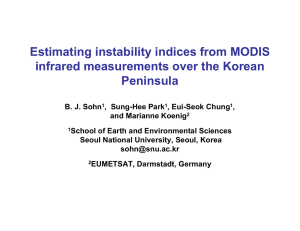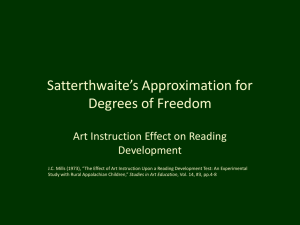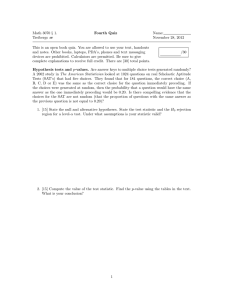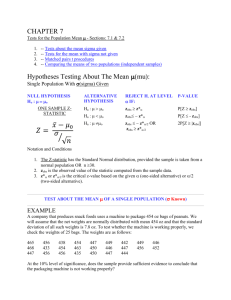Chapter 7 Inference Concerning Populations (Numeric Responses)
advertisement
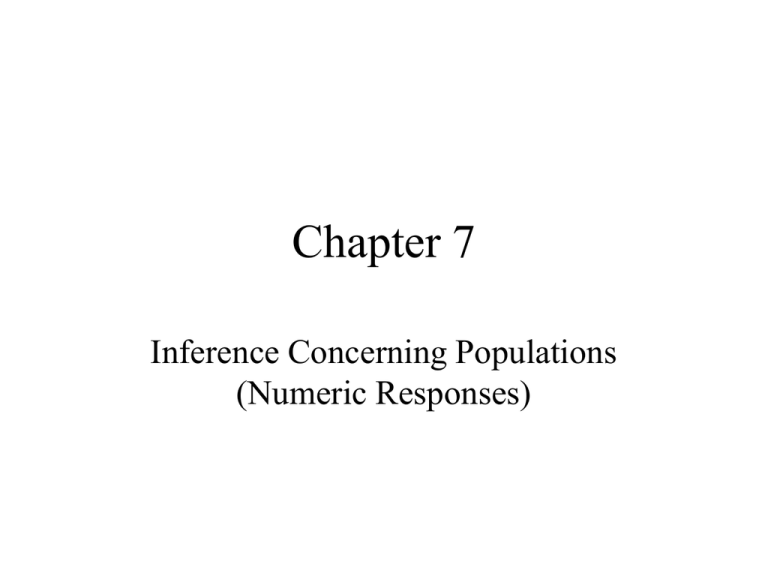
Chapter 7 Inference Concerning Populations (Numeric Responses) Inference for Population Mean • Practical Problem: Sample mean has sampling distribution that is Normal with mean m and standard deviation s / n (when the data are normal, and approximately so for large samples). s is unknown. • Have an estimate of s , s obtained from sample data. Estimated standard error of the sample mean is: s SE x n xm t ~ t (n 1) s n When the sample is SRS from N(m , s) then the t-statistic (same as z- with estimated standard deviation) is distributed t with n-1 degrees of freedom Family of t-distributions • Symmetric, Mound-shaped, centered at 0 (like the standard normal (z) distribution • Indexed by degrees of freedom (n ), the number of independent observations (deviations) comprising the estimated standard deviation. For one sample problems n = n-1 • Have heavier tails (more probability over extreme ranges) than the z-distribution • Converge to the z-distribution as n gets large • Tables of critical values for certain upper tail probabilities are available (inside back cover of text) Probability df D e g r e e s o f F r e e d o m 1 2 3 4 5 6 7 8 9 10 11 12 13 14 15 16 17 18 19 20 21 22 23 24 25 26 27 28 29 30 40 50 60 80 100 1000 z* 0.25 1.000 0.816 0.765 0.741 0.727 0.718 0.711 0.706 0.703 0.700 0.697 0.695 0.694 0.692 0.691 0.690 0.689 0.688 0.688 0.687 0.686 0.686 0.685 0.685 0.684 0.684 0.684 0.683 0.683 0.683 0.681 0.679 0.679 0.678 0.677 0.675 0.674 0.2 1.376 1.061 0.978 0.941 0.920 0.906 0.896 0.889 0.883 0.879 0.876 0.873 0.870 0.868 0.866 0.865 0.863 0.862 0.861 0.860 0.859 0.858 0.858 0.857 0.856 0.856 0.855 0.855 0.854 0.854 0.851 0.849 0.848 0.846 0.845 0.842 0.842 0.15 1.963 1.386 1.250 1.190 1.156 1.134 1.119 1.108 1.100 1.093 1.088 1.083 1.079 1.076 1.074 1.071 1.069 1.067 1.066 1.064 1.063 1.061 1.060 1.059 1.058 1.058 1.057 1.056 1.055 1.055 1.050 1.047 1.045 1.043 1.042 1.037 1.036 0.1 3.078 1.886 1.638 1.533 1.476 1.440 1.415 1.397 1.383 1.372 1.363 1.356 1.350 1.345 1.341 1.337 1.333 1.330 1.328 1.325 1.323 1.321 1.319 1.318 1.316 1.315 1.314 1.313 1.311 1.310 1.303 1.299 1.296 1.292 1.290 1.282 1.282 0.05 6.314 2.920 2.353 2.132 2.015 1.943 1.895 1.860 1.833 1.812 1.796 1.782 1.771 1.761 1.753 1.746 1.740 1.734 1.729 1.725 1.721 1.717 1.714 1.711 1.708 1.706 1.703 1.701 1.699 1.697 1.684 1.676 1.671 1.664 1.660 1.646 1.645 0.025 12.71 4.303 3.182 2.776 2.571 2.447 2.365 2.306 2.262 2.228 2.201 2.179 2.160 2.145 2.131 2.120 2.110 2.101 2.093 2.086 2.080 2.074 2.069 2.064 2.060 2.056 2.052 2.048 2.045 2.042 2.021 2.009 2.000 1.990 1.984 1.962 1.960 0.02 15.89 4.849 3.482 2.999 2.757 2.612 2.517 2.449 2.398 2.359 2.328 2.303 2.282 2.264 2.249 2.235 2.224 2.214 2.205 2.197 2.189 2.183 2.177 2.172 2.167 2.162 2.158 2.154 2.150 2.147 2.123 2.109 2.099 2.088 2.081 2.056 2.054 Critical Values 0.01 31.82 6.965 4.541 3.747 3.365 3.143 2.998 2.896 2.821 2.764 2.718 2.681 2.650 2.624 2.602 2.583 2.567 2.552 2.539 2.528 2.518 2.508 2.500 2.492 2.485 2.479 2.473 2.467 2.462 2.457 2.423 2.403 2.390 2.374 2.364 2.330 2.326 0.005 63.66 9.925 5.841 4.604 4.032 3.707 3.499 3.355 3.250 3.169 3.106 3.055 3.012 2.977 2.947 2.921 2.898 2.878 2.861 2.845 2.831 2.819 2.807 2.797 2.787 2.779 2.771 2.763 2.756 2.750 2.704 2.678 2.660 2.639 2.626 2.581 2.576 0.0025 127.3 14.09 7.453 5.598 4.773 4.317 4.029 3.833 3.690 3.581 3.497 3.428 3.372 3.326 3.286 3.252 3.222 3.197 3.174 3.153 3.135 3.119 3.104 3.091 3.078 3.067 3.057 3.047 3.038 3.030 2.971 2.937 2.915 2.887 2.871 2.813 2.807 0.001 318.3 22.33 10.21 7.173 5.894 5.208 4.785 4.501 4.297 4.144 4.025 3.930 3.852 3.787 3.733 3.686 3.646 3.610 3.579 3.552 3.527 3.505 3.485 3.467 3.450 3.435 3.421 3.408 3.396 3.385 3.307 3.261 3.232 3.195 3.174 3.098 3.090 0.0005 636.6 31.60 12.92 8.610 6.869 5.959 5.408 5.041 4.781 4.587 4.437 4.318 4.221 4.140 4.073 4.015 3.965 3.922 3.883 3.850 3.819 3.792 3.768 3.745 3.725 3.707 3.689 3.674 3.660 3.646 3.551 3.496 3.460 3.416 3.390 3.300 3.290 C r i t i c a l V a l u e s t(5), t(15), t(25), z distributions Density t(5) t(15) t(25) z -4 -3 -2 -1 0 1 2 3 4 One-Sample Confidence Interval for m • SRS from a population with mean m is obtained. • Sample mean, sample standard deviation are obtained • Degrees of freedom are n = n-1, and confidence level C are selected • Level C confidence interval of form: s xt n t * selected from t - table so that P(t * t (n 1) t * ) C * Procedure is theoretically derived based on normally distributed data, but has been found to work well regardless for large n 1-Sample t-test (2-tailed alternative) • 2-sided Test: H0: m = m0 Ha: m m0 • Decision Rule (t* obtained such that P(t(n-1) t*)=a/2) : – Conclude m > m0 if Test Statistic (tobs) is greater than t* – Conclude m < m0 if Test Statistic (tobs) is less than -t* – Do not conclude Conclude m m0 otherwise • P-value: 2P(t(n-1) |tobs|) • Test Statistic: tobs x m0 s/ n P-value (2-tailed test) t(n-1) P -value -4 -3 -2 -|tobs| -1 0 1 |tobs| 2 3 4 1-Sample t-test (1-tailed (upper) alternative) • 1-sided Test: H0: m = m0 Ha: m > m0 • Decision Rule (t* obtained such that P(t(n-1) t*)=a) : – Conclude m > m0 if Test Statistic (tobs) is greater than t* – Do not conclude m > m0 otherwise • P-value: P(t(n-1) tobs) • Test Statistic: tobs x m0 s/ n P-value (Upper Tail Test) t(n-1) P-value -4 -3 -2 -1 0 1 tobs 2 3 4 1-Sample t-test (1-tailed (lower) alternative) • 1-sided Test: H0: m = m0 Ha: m < m0 • Decision Rule (t* obtained such that P(t(n-1) t*)=a) : – Conclude m < m0 if Test Statistic (tobs) is less than -t* – Do not conclude m < m0 otherwise • P-value: P(t(n-1) tobs) • Test Statistic: tobs x m0 s/ n P-value (Lower Tail Test) t(n-1) P-value -4 -3 -2 tobs -1 0 1 tobs 2 3 4 Example: Mean Flight Time ATL/Honolulu • Scheduled flight time: 580 minutes • Sample: n=31 flights 10/2004 (treating as SRS from all possible flights • Test whether population mean flight time differs from scheduled time • H0: m = 580 Ha: m 580 • Critical value (2-sided test, a = 0.05, n-1=30 df): t*=2.042 • Sample data, Test Statistic, P-value: x 574.1 s 19.7 n 31 574.1 580 5.9 tobs 1.67 3.54 19.7 / 31 P - value 2 P(t (30) | 1.67 |) 2 P(t (30) 1.697) 2(.05) .10 Paired t-test for Matched Pairs • Goal: Compare 2 Conditions on matched individuals (based on similarities) or the same individual under both conditions (e.g. before/after studies) • Obtain the difference for each pair/individual • Obtain the mean and standard deviation of the differences • Test whether the true population means differ (e.g. H0:mD = 0) • Test treats the differences as if they were the raw data Test Concerning mD • Null Hypothesis: H0:mD=D0 (almost always 0) • Alternative Hypotheses: – 1-Sided: HA: mD > D0 – 2-Sided: HA: mD D0 • Test Statistic: tobs d sd n Test Concerning mD Decision Rule: (Based on t-distribution with n=n-1 df) 1-sided alternative If tobs t* ==> Conclude mD D0 If tobs < t* ==> Do not reject mD D0 2-sided alternative If tobs t* ==> Conclude mD D0 If tobs -t* ==> Conclude mD < D0 If -t* < tobs < t* ==> Do not reject mD D0 Confidence Interval for mD sd d t n * Example Antiperspirant Formulations • Subjects - 20 Volunteers’ armpits • Treatments - Dry Powder vs Powder-in-Oil • Measurements - Average Rating by Judges – Higher scores imply more disagreeable odor • Summary Statistics (Raw Data on next slide): d 0.15 sd 0.248 n 20 Source: E. Jungermann (1974) Example Antiperspirant Formulations Subject 1 2 3 4 5 6 7 8 9 10 11 12 13 14 15 16 17 18 19 20 Dry Powder 2 2.8 1.3 1.8 1.9 2.8 2 1.5 1.9 2.9 2.9 2.3 2.3 3.6 2.2 2.1 2.5 2.4 3.1 2 Powder-in-Oil Difference 1.9 0.1 2.4 0.4 1.5 -0.2 1.8 0 1.8 0.1 2.4 0.4 2.2 -0.2 1.5 0 1.7 0.2 2.8 0.1 2.7 0.2 1.5 0.8 2.5 -0.2 3.2 0.4 2.1 0.1 1.9 0.2 2.6 -0.1 2 0.4 2.9 0.2 1.9 0.1 0.15 Mean 0.248151058 Std Dev Example Antiperspirant Formulations H 0 : m D 0 (No difference in formulatio n effects) H A : m D 0 (Formulati on effects differ) TS : tobs d 0.15 0.248 sd n 20 0.15 2.70 .0555 RR : tobs t.025, 201 t.025,19 2.093 P value 2P(t 2.70) sd 95% CI for m D : d t.025,n 1 n 0.15 2.093(.0555) 0.15 0.116 (0.034,0.266) Evidence that scores are higher (more unpleasant) for the dry powder (formulation 1) Comparing 2 Means - Independent Samples • Goal: Compare responses between 2 groups (populations, treatments, conditions) • Observed individuals from the 2 groups are samples from distinct populations (identified by (m1,s1) and (m2,s2)) • Measurements across groups are independent (different individuals in the 2 groups • Summary statistics obtained from the 2 groups: Group 1 : Mean : x1 Std. Dev. : s1 Sample Size : n1 Group 2 : Mean : x 2 Std. Dev. : s2 Sample Size : n2 Sampling Distribution of X1 X 2 • Underlying distributions normal sampling distribution is normal • Underlying distributions nonnormal, but large sample sizes sampling distribution approximately normal • Mean, variance, standard deviation: ( V (X ) ) s E X 1 X 2 m X 1 X 2 m1 m 2 sX 1 X 2 1X 2 s 12 n1 2 X1X 2 s 22 n2 s 12 n1 s 22 n2 t-test when Variances are estimated • Case 1: Population Variances not assumed to be equal (s12s22) • Approximate degrees of freedom – Calculated from a function of sample variances and sample sizes (see formula below) - Satterthwaite’s approximation – Smaller of n1-1 and n2-1 • Estimated standard error and test statistic for testing H0: m1=m2: ( ) Estimated standard error : SE X 1 X 2 Test Statistic : t obs s12 s22 n1 n2 X1 X 2 X1 X 2 SE X 1 X 2 s12 s22 n1 n2 Satterthwa ite' s df : n ( ) s12 s22 n n 2 1 2 2 s 2 2 s 2 1 2n n 1 2 n 1 n 1 1 2 t-test when Variances are estimated • Case 2: Population Variances assumed to be equal (s12=s22) • Degrees of freedom: n1+n2-2 • Estimated standard error and test statistic for testing H0: m1=m2: ( ) Estimated standard error : SE X 1 X 2 Test Statistic : t obs X1 X 2 SE X 1 X 2 ( 2 2 ( n 1 ) s ( n 1 ) s 1 2 2 s 2p 1 n1 n2 2 ) 1 1 s n1 n2 2 p X1 X 2 1 1 s n1 n2 2 p Example - Maze Learning (Adults/Children) • Groups: Adults (n1=14) / Children (n2=10) • Outcome: Average # of Errors in Maze Learning Task • Raw Data on next slide Mean Std Dev Sample Size Adults (i=1) 13.28 4.47 14 Children (i=2) 18.28 9.93 10 • Conduct a 2-sided test of whether mean scores differ • Construct a 95% Confidence Interval for true difference Source: Gould and Perrin (1916) Example - Maze Learning (Adults/Children) Name H W Mac McG L R Hv Hy F Wd Rh D Hg Hp Hl McS Lin B N T J Hz Lev K Group Trials 1 1 1 1 1 1 1 1 1 1 1 1 1 1 2 2 2 2 2 2 2 2 2 2 41 25 33 31 41 48 24 32 46 47 35 69 27 27 42 89 38 20 49 40 50 40 54 58 Errors Average 728 17.76 333 13.32 453 13.73 528 17.03 335 8.17 553 11.52 217 9.04 711 22.22 839 18.24 473 10.06 532 15.20 538 7.80 213 7.89 375 13.89 254 6.05 1559 17.52 1089 28.66 254 12.70 599 12.22 520 13.00 828 16.56 516 12.90 2171 40.20 1331 22.95 Group n 1 2 Mean Std Dev 14 13.28 4.47 10 18.28 9.93 Example - Maze Learning Case 1 - Unequal Variances H0: m1m2 0 S12 ( 4.47) 2 1.43 n1 14 HA: m1m2 0 (a = 0.05) S 22 (9.93) 2 9.86 n2 10 (1.43 9.86 )2 127.46 n 11.63 2 2 10.96 (1.43) (9.86) 9 13 13.28 18.28 5.00 TS : t obs 1.49 2 2 3.36 ( 4.47) (9.93) 14 10 RR : | t obs | t.025,11.63 2.19 * 95%CI : 5.00 2.19(3.36) 5.00 7.36 ( 12.36,2.36) No significant difference between 2 age groups Note: Alternative would be to use 9 df (10-1) Example - Maze Learning Case 2 - Equal Variances H0: m1m2 0 HA: m1m2 0 (a = 0.05) (14 1)( 4.47) 2 (10 1)(9.93) 2 s 52.15 14 10 2 13.28 18.28 5.00 TS : tobs 1.67 2.99 1 1 52.15 14 10 RR : | tobs | t.025, 22 2.074 2 p 95%CI : 5.00 2.074( 2.99) 5.00 6.20 ( 11.2,1.2) No significant difference between 2 age groups SPSS Output S t E e N e e G A A 4 1 4 8 C 0 9 9 2 S s u f a V o n a l e r . e E a e e o 2 F d p i t r r w g f p e e A E 0 7 2 2 9 8 7 1 5 a E 8 1 3 8 4 7 1 n C% Confidence Interval for m1-m2 ) (x ( Case 1 s 12 s 22 : ) * x t 1 2 s12 s22 n1 n2 df Satterthwa ite or smaller of n1 1, n2 1 Maze Data (df 11.63 or could use 9) : 95%CI : 5.00 2.19(3.36) 5.00 7.36 (12.36,2.36) ( ) (x Case 2 s s : 2 1 2 2 1 ) x2 t * 1 1 s n1 n2 2 p df n1 n2 2 Maze Data (df 22) : 95%CI : 5.00 2.074(2.99) 5.00 6.20 (11.2,1.2)
